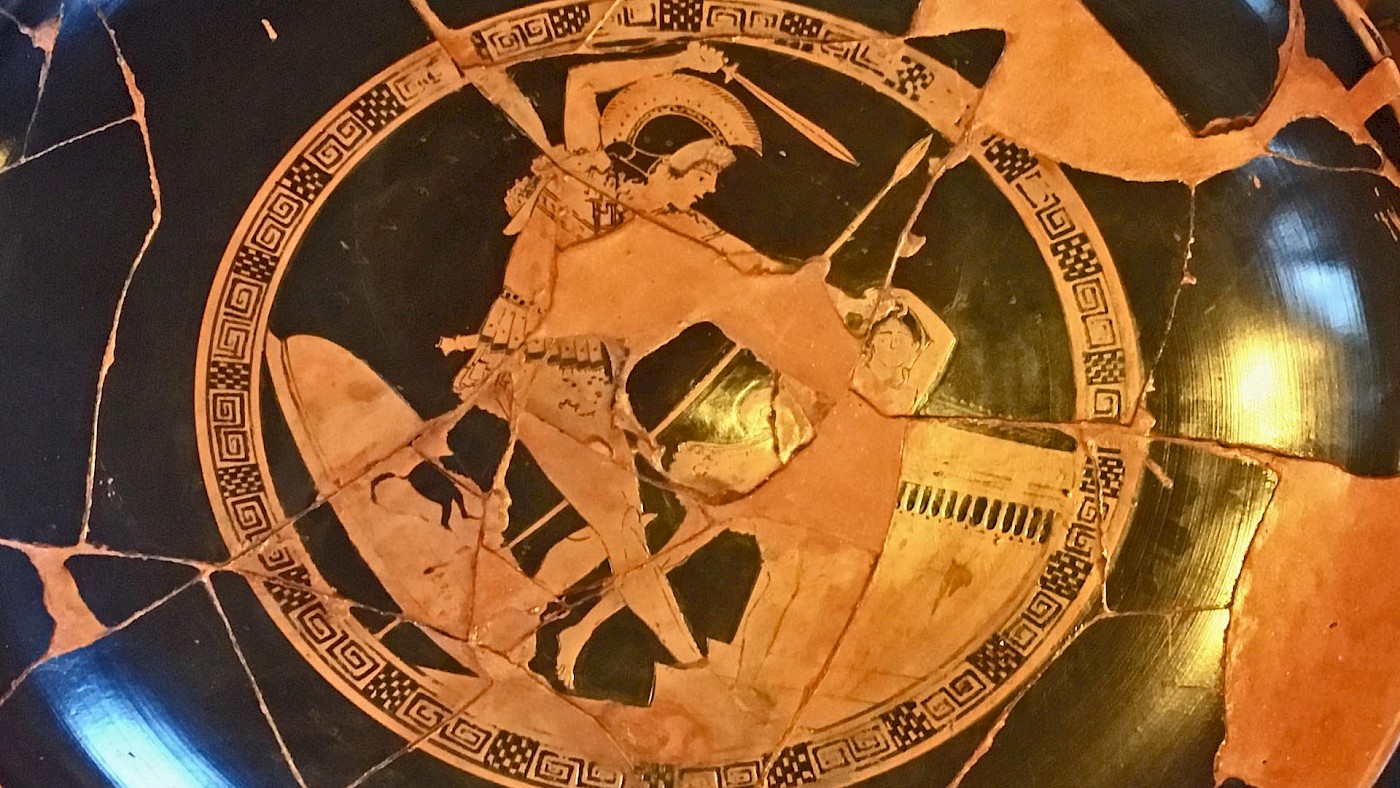The archaeological museum of Orvieto has a number of fine examples of Greek painted pottery with figurative scenes. One of my favourites is an Attic red-figure kylix (cup) found at Vulci. An inscription identifies the creator as Euphronius. The museum says he was the potter, and presumably on stylistic grounds identifies the painter as Onesimos. It dates to ca. 490 BC.
The inside of the cup depicts a warrior about to strike down what appears to be an unarmed young man, perhaps even a child. Inscriptions identify the warrior as Achilles and the child as Troilus, but even without these labels it would still have been easy to identify the scene, thanks to the altar depicted just to the right of the boy.
The killing of Troilus
This scene was remarkably popular in Greece during the Archaic and early Classical periods. There are many pots that depict Achilles either in an ambush, preparing for Troilus to water his horse at a fountain, or chasing after the boy. Scenes like the one on this kylix, with the Greek hero poised to send Troilus’ shade groaning to the underworld – to borrow a phrase from Virgil’s Aeneid – are also fairly common.
Troilus was the youngest son of Priam, the king of Troy, and Hecuba, and therefore a brother of Hector and Paris. His death is mentioned briefly by Priam in the final book of the Iliad, but no details are given. There were references to Achilles’ slaying of Troilus in earlier epics, now lost, such as the Cypria, but the details are vague: for the most part, we know early versions of this story primarily from figurative rather than literary evidence.
What exactly had Troilus done wrong to be snuffed out at what seems a tender age? According to the conventional stories about the Trojan War, there were a number of tasks that the Greeks had to complete before Troy could be sacked. These tasks included stealing the Palladium (a sacred statue of Athena), retrieving the bow of Heracles, and – you guessed it – killing Troilus.
Later writers suggested that Troilus fought during the war, and some later ancient works of art depict him with weapons and even armour. But in most early depictions, including this kylix in the museum of Orvieto, Troilus is depicted as a helpless youth, mercilessly slain by the Greek champion. Weirdly, Troilus managed to become rather popular during the Middle Ages, when stories about his love affair with the entirely post-Classical character of Cressida were invented.
Vulci, the place where the kylix depicted at the top of this article was found, was an Etruscan city. Rightly or wrongly, the Etruscans are said to have had rather bloodthirsty tastes when it came to art. The scene of Achilles waiting to kill or actually in the process of murdering Troilus were popular among the Etruscans, as also demonstrated, for example, by a wall-painting in the Tomb of the Bulls near Tarquinia.
The significance of the scene
Why was this image of Achilles killing a Trojan boy depicted on the inside of a drinking cup? Ancient symposia were usually organized by wealthy men, who would drink, engage in discussions on a variety of serious and not-so-serious topics, sing songs, engage in sexual behaviour, and so forth. Wine flowed freely, so things could naturally get rowdy.
The kylix dates from the early fifth century BC, when practices such as pederasty were commonplace, at least in ancient Athens, where this cup was made. Among the Greeks, the image of Troilus could have been used as the starting off point to celebrate youthful beauty in a general sense or to sing the praises of a living youth in particular.
But while the cup was produced in Greece, it was consumed by Etruscans. Pederasty isn’t clearly attested in Etruria, so the image may have had a different meaning to them. Joshua Hall suggested to me that the Troilus scene appealed to the Etruscans because it shows Achilles carrying out a divine commandment with physical force, a popular theme in Etruscan myth.
Furthermore, his death at the hands of Achilles ensured that he never grew old and ugly, preserving his youthful image for all eternity, in a manner earlier touched upon in my discussion of the story of Cleobis and Biton. The main difference, of course, is that Troilus hadn’t actually performed any noteworthy deeds, but perhaps his youth and features were enough.
The story of Troilus reminds us, if that were necessary, that the ancient world was quite different from our own. At least, one would hope that people today wouldn’t celebrate a champion whose accomplishments included the killing of defenceless children. In that regard, Achilles is perhaps even worse of a hero than Odysseus.
